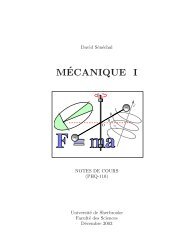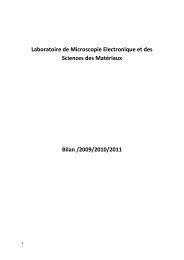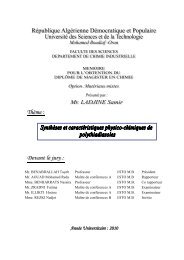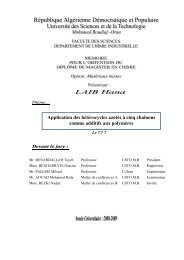Baziz Meriem magister.pdf - Université des Sciences et de la ...
Baziz Meriem magister.pdf - Université des Sciences et de la ...
Baziz Meriem magister.pdf - Université des Sciences et de la ...
Create successful ePaper yourself
Turn your PDF publications into a flip-book with our unique Google optimized e-Paper software.
Intensité(%)<br />
120<br />
110<br />
100<br />
(110)<br />
PANI-HCl<br />
90<br />
80<br />
70<br />
60<br />
(001)<br />
(010)<br />
(100)<br />
50<br />
40<br />
30<br />
20<br />
10<br />
0<br />
5 10 15 20 25 30 35 40 45 50<br />
2 th<strong>et</strong>a(°)<br />
Figure IV.4: Diffractogramme RX <strong>de</strong> <strong>la</strong> PANI- ES.<br />
IV.3.3. Spectroscopie UV-Visible<br />
Le passage <strong>de</strong> <strong>la</strong> forme iso<strong>la</strong>nte à <strong>la</strong> forme conductrice est accompagné par un<br />
changement <strong>de</strong> couleur <strong>de</strong> <strong>la</strong> polyaniline, qui peut facilement être caractérisé par<br />
spectroscopie UV-Visible. Les spectres UV-Visible <strong>de</strong> <strong>la</strong> PANI dans sa forme sel <strong>et</strong> sa forme<br />
base dissoute dans le diméthyle sulfoxi<strong>de</strong> (DMSO) sont représentés sur les Figures IV.5.a-b.<br />
La Figure IV.5.a montre <strong>la</strong> forme éméraldine base du polymère synthétisé [15]. Le<br />
spectre montre <strong>de</strong>ux maximums d’adsorptions situés à 338 nm <strong>et</strong> à 633 nm associés<br />
respectivement à <strong>la</strong> transition électronique (π-π * ) re<strong>la</strong>tive aux électrons du système benzoï<strong>de</strong><br />
délocalisé sur les atomes d’azote <strong><strong>de</strong>s</strong> sites amine du polymère <strong>et</strong> à <strong>la</strong> transition <strong><strong>de</strong>s</strong> électrons<br />
entre l’orbitale molécu<strong>la</strong>ire occupée <strong>de</strong> plus haute énergie (HOMO) du système benzoï<strong>de</strong> <strong>et</strong><br />
l’orbitale molécu<strong>la</strong>ire <strong>de</strong> plus base énergie (LUMO) du système quinoï<strong>de</strong> du polymère [16,<br />
17].<br />
Le spectre UV-Visible <strong>de</strong> <strong>la</strong> PANI protonée montre <strong><strong>de</strong>s</strong> différences par rapport au<br />
spectre <strong>de</strong> <strong>la</strong> PANI-EB (Figure IV.5.b). On remarque ainsi l’apparition <strong>de</strong> nouvelles ban<strong><strong>de</strong>s</strong><br />
vers à 440 nm <strong>et</strong> 780 nm <strong>et</strong> <strong>la</strong> disparition complètement <strong>de</strong> <strong>la</strong> ban<strong>de</strong> d'absorption à 633 nm<br />
tandis que l’intensité <strong>de</strong> <strong>la</strong> ban<strong>de</strong> située à 338 nm, diminue considérablement. Ces ban<strong><strong>de</strong>s</strong> sont<br />
caractéristiques <strong>de</strong> <strong>la</strong> polyaniline protonée [18, 19]. Elles correspon<strong>de</strong>nt aux transitions<br />
électroniques π-π* (ban<strong>de</strong> à 360 nm), π-po<strong>la</strong>ron (ban<strong>de</strong> à 440 nm) <strong>et</strong> po<strong>la</strong>ron-π* (ban<strong>de</strong> <strong>la</strong>rge<br />
à 780 nm).
















